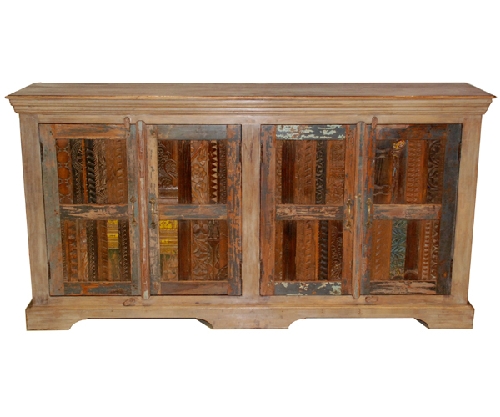Ultimate recycling project

Forty years ago, Americans across the nation started a grassroots effort to help protect the environment. Today, as we mark Earth Day, we are doing more each day to make the world greener.
Our efforts range the gamut from recycling aluminum cans and plastic bottles to creating furniture out of reclaimed wood.
“Using reclaimed wood helps the environment when properly executed. It is recycling in its truest form,” said Paul Watson, a licensed architect, interior designer and owner of interior design firm Architectural Interiors who currently serves as leasing director for Las Vegas Design Center.
Simply put, it means taking a piece of wood that has been used before and giving it new life by repurposing it, said Susan Inglis, executive director of the Sustainable Furniture Council.
“It can be reclaimed from any number of places,” she said singling out council members such as Urban Woods, which reclaims wood from warehouses and old buildings in the “urban jungle” of Los Angeles that are being torn down; and Tucker Robbins, the New York-based firm that often salvages wood from trees that are downed in large storms.
“There is clearly a green message here,” said Mark Phillips, president and chief executive officer of The Phillips Collection, which is known for its eco-friendly furnishings. “We are communing with nature, not sending out an order to cut new trees, but responsibly managing and more effectively utilizing what already exists.”
The High Point, N.C.-based firm, which has a showroom at the Las Vegas Design Center, works with rescued roots from long-ago felled trees as well as odd cut pieces of leftover wood that would normally be burned or discarded.
Phillips said people are buying furniture made from reclaimed woods because the pieces are “drop-dead gorgeous. If it isn’t beautiful, this doesn’t work.
“It just so happens that nature is an amazing talent. So, if we are smart enough to know how to harness this talent, we’ve got a great palette and a great product to present. It’s a natural — excuse the pun,” he added. “As long as the product is gorgeous, it will sell.”
Each piece made from reclaimed wood should be treated as a piece of art because of its uniqueness, said Carol Seibel, showroom manager for Classic Home at the Las Vegas Design Center.
“They are never exactly alike. We can make them the same size, use the same fittings and the same colorations, but each piece is truly one-of-a-kind,” she said.
The Southern California-based company uses acacia, shesham and mango wood from old buildings and ships, old wagon wheels and railroad ties found in India as well as decorative blocks used in paper and fabric printing to create its furnishings.
“This makes otherwise common goods unique; no two pieces are alike,” agreed Watson.
Because of this, furnishings made from reclaimed woods can fit into nearly any setting and decorating style.
“Put one piece into a room and it mixes with everything — that’s what designers are figuring out,” Seibel said.
In addition, the wooden furnishings bring in a layer of texture to a home’s décor. “Reclaimed materials, like driftwood, add to the complexion,” Watson said.
“Reclaimed wood can be used to produce absolutely any look,” said Inglis.
As another source of wood, the material can be refashioned to suit the manufacturers’ needs, and, in some cases, play up the fact that the wood has been used before.
“Sometimes, that’s the look they want,” Inglis added.
The reclaimed wood also can be blended with other woods to create furnishings.
Earlier this week at the biannual furniture market in High Point, N.C., Turning House Furniture introduced its new Ecøtak line, which uses one-quarter vintage wood bonded to Forest Stewardship Council-certified birch plywood.
“Ecøtak moves us ever closer to being a zero-waste facility because we are able to use more of the reclaimed timber in the process, said Spencer Wood Morten III, chairman and CEO of the Bassett, Va.-based company. “It does no good to recycle only 50 to 60 percent of the reclaimed wood, especially when it comes to heirloom species like wormy American chestnut.”
The company is able to saw vintage American timber precisely to create higher yields from wood that has been reclaimed from industrial-era buildings.
“It takes skill and craftsmanship to incorporate reclaimed materials into usable goods on a broad scale,” Watson said.
Using reclaimed woods for furniture certainly sends out a message about conservation, Inglis said.
Inglis said their research shows that 75 percent of people are at least a little bit concerned about the global warming crisis and recycling is the number one thing they are doing to help.
“In furnishings, it’s style, quality and price that drive the sale. So when we talk to consumers about what they are aware of, the number one product they are aware of is recycled content or reclaimed wood,” Inglis said, adding that 60 percent of people notice if a product they are buying has recycled material.
Despite this increased awareness, Phillips said the key to getting consumers to purchase furnishings made of reclaimed woods is to make sure they are pieces people want to have in their homes.
“It’s up to us to come up with compelling products. The public is smart enough to recognize the beauty of it. They buy the piece not because it’s green, but because it’s also green,” he said.